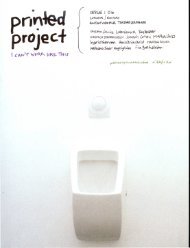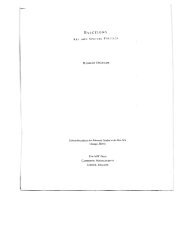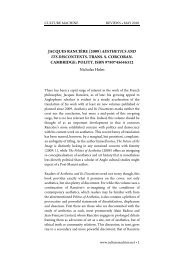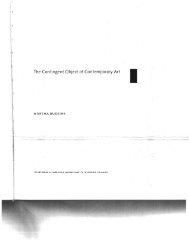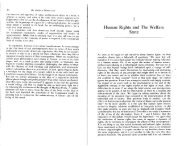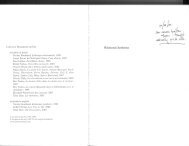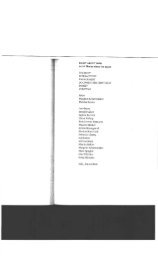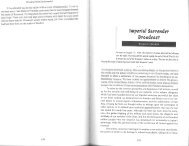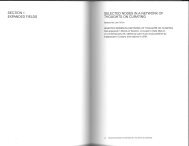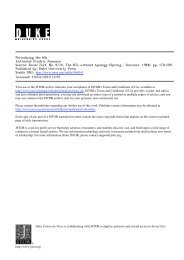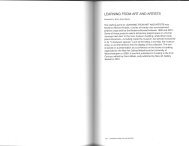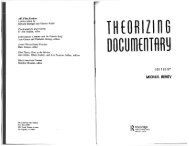Maria Lind, "The Curatorial" - doublesession
Maria Lind, "The Curatorial" - doublesession
Maria Lind, "The Curatorial" - doublesession
You also want an ePaper? Increase the reach of your titles
YUMPU automatically turns print PDFs into web optimized ePapers that Google loves.
THE CURATORIAL<br />
Selected by Liam Gillick<br />
THE CURATORIAL was commissioned by Artforum as the inaugural<br />
column in a series on curating, published in October 2009. This is the<br />
original version of that text.<br />
57. THECURATORIAL
58. SELECTED MARIA LIND WRITING<br />
LAMYA HUSSAIN<br />
GARGASH, FROM<br />
FAMILIAL SERIES, 2OO9<br />
C-print on aluminum,<br />
12O x 12O cm.<br />
United Arab Emirates Pav¡l¡on at<br />
the Venice Biennale. 2009-<br />
HANNAH HURTZIG,<br />
KIOSK FOR USEFUL<br />
KNOWLEDGE_SPACE<br />
CONTROL 11: NATION<br />
BUILDERS,2OO9<br />
lnstallation view.<br />
United Arab EmiÉtæ Pav¡l¡on at<br />
the Venice B¡ennale, 2009.<br />
Exhibition view of models<br />
of existing museums in the<br />
United Arab Emirates and<br />
architectural projects in<br />
the making.<br />
United Arab Em¡rates Pavil¡on at<br />
the Ven¡ce Biennale. 2009.<br />
JACKSON POLLOCK BAR<br />
A reenactment in the<br />
space of the UAE<br />
Pavilion of the first press<br />
conference given in Miami<br />
by the Pavilion's curator<br />
and commissioner in<br />
December 2008.<br />
Un¡ted Arab Em¡rates Pavìlion at<br />
the Venice B¡enn¡al, 2009.<br />
59. THECURATORIAL
Exhibition view of the 2008<br />
São Paulo Biennial, with<br />
floor by Dora Longo Bahia.<br />
ANGELA FERREIRA, FOR<br />
MOZAMBTQUE (MODEL<br />
#3 FOR PROPAGANDA<br />
STAND, SCREEN<br />
AND LOUDSPEAKER<br />
PLATFORM<br />
CELEBRATING A<br />
POST-INDEPENDENCE<br />
uToPtA),2008.<br />
Exhibition view, 2008<br />
São Paulo Biennial.<br />
LEYA MIRA BRANDER,<br />
UNTITLED, 2OO8<br />
Prints: dry point, etching,<br />
and aquatint. Variable<br />
dimensions. Vitrines<br />
designed by Gabriel<br />
Sierra. Exhibition vieW<br />
2008 São Paulo Biennial.<br />
View of the nearly empty<br />
second floor of Oscar<br />
Niemeyer's building for the<br />
2008 São Paulo Biennial.<br />
60. SELECTED MARIA LIND WBITING 61. THECURATORIAL
THE CURATORIAL<br />
ls there something we can call "the curatorial"? Something that<br />
manifests itself in the activities of a curator, whether employed<br />
or independent, trained as an aftist or as an art historian? lt<br />
is clear that curating is much more than making exhibitions: it<br />
involves commissioning new work and working beyond the walls<br />
of an institution, as well as beyond what are traditionally called<br />
programming and education. But can we speak of "the curatorial"<br />
beyond "curating in the expanded field": as a multidimensional role<br />
that includes critique, editing, education, and fundraising?<br />
Following this year's Venice Biennale, I am pondering how "the<br />
curatorial" can contain all these varied dimensions as a loose<br />
methodology applied by different people in various capacities. Today<br />
I imagine curating as a way of thinking in terms of interconnections:<br />
linking objects, images, processes, people, locations, histories, and<br />
discourses in physical space like an active catalyst, generating twists,<br />
turns, and tensions. This is a curatorial approach that owes much to<br />
site-specific practices, and even more to context-sensitive work and<br />
various traditions of institutional critique-each encouraging you to<br />
think from the artwork, with it, but also away from it and against it. ln<br />
this sense, "the curatorial" resembles what an editor should do, only<br />
with a broader set of materials and relationships.<br />
<strong>The</strong> United Arab Emirates pavilion in Venice comes to mind as an<br />
example. <strong>The</strong> first showing of the UAE offered photographic work<br />
by Lamya Gargash, videotaped dialogues with state officials and<br />
academics by Hannah Hurtzig, architectural models of museums by<br />
star architects planned for the country, performative interpretations of<br />
some of the usual public-relations procedures by the Jackson Pollock<br />
Bar, and an online archive documenting works by UAE artists. With<br />
this pavilion, curator Tirdad Zolghadr assembled one of the Biennale's<br />
highlights. <strong>The</strong> wittiest, and yet most thoughtful audio guide I have<br />
ever come across introduced visitors to this unusually complex<br />
political, economic, social, and artistic situation in which the curator<br />
worked through both affirmation and critique. Here, "the curatorial"<br />
emerges in the multiplicity of connections and layers, in how they are<br />
orchestrated to challenge the status quo, with the works themselves<br />
placed at the center of the project.<br />
63 THECURATORIAL
Understood in this way, "the curatorial" operates in parallel with<br />
Chantal Mouffe's notion of "the political." ln her quest for a better<br />
model of democracy than the representative forms we think we know,<br />
she sketches one in which opposition is lauded and consensus, with<br />
its predilection for closure, becomes highly problematic. Leaning<br />
on Carl Schmitt, Mouffe argues for "the political" as an ever-present<br />
potential that cannot be precisely located, yet grows out of the<br />
antagonistic bond between friend and enemy. "<strong>The</strong> political" is an<br />
aspect of life that cannot be distinguished from divergence and<br />
dissent-the antithesis of consensus. For Mouffe, "politics" is the<br />
formal side of practices that reproduce certain orders. Seen this way,<br />
"curating" would be the technical modality-which we know from ad<br />
institutions and independent projects-and "the curatorial" a more<br />
viral presence consisting of signification processes and relationships<br />
between objects, people, places, ideas, and so forth, a presence that<br />
strives to create friction and push new ideas.<br />
<strong>The</strong> recent São Paulo Biennial, co-curated by lvo Mesquita and Ana<br />
Paula Cohen in fall 2008, is another more extensive case where "the<br />
curatorial" came to the fore. Among the two hundred or so biennials<br />
in the world, São Paulo is one of the oldest. Since its inception<br />
in 195'1 , it has created and renewed connections and stimulated<br />
debates as one of Latin America's most imporlant platforms for both<br />
international and local modern and contemporary arf. Today, with a<br />
different art topography that includes a number of local and regional<br />
art institutions and organizations, the São Paulo Biennial's original<br />
role as popular educator is less relevant. Mesquita and Cohen took<br />
this change of landscape as a starting point: lf it no longer needs to<br />
educate audiences, could its role not be to reflect upon the very role<br />
of the biennial itself, and upon the kind of art that does not receive<br />
space and attention from other mainstream venues; namely, processoriented<br />
art of which collections and archival practices lie at the core?<br />
Hugely controversial, but to my mind thought-provoking and<br />
refreshing, the 2008 São Paulo Biennial invited you to study Leya<br />
Mira Brander's many detailed and deeply personal copper prints in<br />
low vitrines. lt allowed you to read about Jean-Luc Godard's work<br />
with state television in Mozambique in a sculpture by Angela Ferrara.<br />
And you could print your own booklet of photographs from Armin<br />
Linke's own archive, with motifs from literally the whole world. <strong>The</strong><br />
previous "department store" exhibition model with ar1 in every square<br />
centimeter of the space was replaced by a spaciously installed<br />
64 SELECTED MAFìIA LIND WRITING<br />
thematic group exhibition with an almost completely empty floor, a<br />
"town square" for film, music, and dance performances on the ground<br />
floor, plus a well-selected archive of video art at the bottom. All of<br />
which angered those who expected business as usual, aft en masse<br />
with plenty of well-known artists.<br />
Having around forty artists in the exhibition left time to engage with<br />
each individual work, many of which demanded focused attention.<br />
ln addition, the architecture of Oscar Niemeyeç with a Le Corbusierinspired<br />
open plan on three floors, participated for the first time<br />
alongside the artworks. This biennial had a sense of relief from the<br />
impossible burden of representing the vast category of contemporary<br />
art with each edition, filling the space to the brim with artworks. Yet<br />
the curators of the 2008 edition reintroduced the biennial with a new<br />
approach to it in terms of what I am calling "the curatorial." Here, "the<br />
curatorial" lies in the careful consideration of the biennial's history,<br />
the current institutional situation in São Paulo and in Brazil, and in the<br />
combination of artists and types of artworks, as well as in the spatial<br />
organization.<br />
Figures from lrit Rogoff to Liam Gillick have identified curating as a<br />
locus within contemporary art from which significant new ideas have<br />
emerged since the mid-1990s-at least in Europe, Latin America,<br />
and the Middle East-rather than from other times and places<br />
when art criticism or aft history had the privilege of formulating<br />
the agenda. I am tempted to read "the curatorial" in these artists'<br />
argument: rather than being the product of curators per se, curating<br />
is the result of a network of agents' labor. <strong>The</strong> outcome should have<br />
the disturbing quality of smooth surfaces being stirred-a specific,<br />
multilayered means of answering back in a given context. Rather<br />
than representing, "the curatorial" involves presenting-it pedorms<br />
something in the here and now instead of merely mapping it from<br />
there and then. ln this sense, "the curatorial" is a qualitative term just<br />
like "the political" is for Mouffe.<br />
Although it may sound self-satisfied, I think there is some truth to<br />
Rogoff's and Gillick's argument. But an unavoidable question arises:<br />
Has "the curatorial" produced more than merely an irritation? More<br />
than a temporary frisson? Has it had any more profound effect on how<br />
we approach and deal with art and the rest of the world? l'm not sure<br />
yet-more time must pass before we can tell. But I do know that the<br />
business of traditional curating, like the car industry, needs to rethink
its modes of production. lf "the curatorial"-in a less qualitative and<br />
a more deadpan use of the term-can be present in the work of<br />
practically anybody active within the field of contemporary aft, it could<br />
also be used as an escape route for someone who, like myself, is<br />
responsible for graduating fifteen curatorial students per year. Where<br />
will they find work? Given the proliferation of curatorial programs<br />
across the globe, some creative thinking has to be done to determine<br />
which jobs they should look for. <strong>The</strong> existing curatorial positions<br />
simply won't suffice.<br />
ô6. SE|+CTED MAFTA UND WRtTlNc



